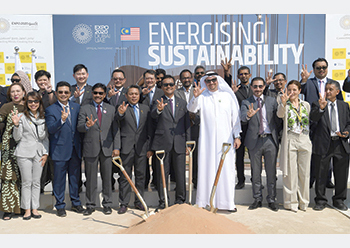Malaysia kicks off work on ‘Rainforest Canopy’
01 November 2019
Malaysia last month kicked off the construction of its ‘Rainforest Canopy’ pavilion for the World Expo 2020. The construction contractor from Malaysia, Qube Integrated, and local partner RAQ Contracting are working together to build the pavilion. The company was awarded a contract last month to co-develop the site infrastructure which will focus on sustainable design.
Designed by Hijjas Architects + Planners, a Kuala Lumpur-based firm, The Rainforest Canopy was inspired by Malaysia’s oldest rainforests, which include its prehistoric Taman Negara in Pahang – Malaysia’s premier national park estimated to be over 130 million years old.
The net zero-carbon facility will be coming up within the 4.38-sq-km Sustainability District, said Malaysia’s Ministry of Energy, Science, Technology, Environment, and Climate Change (MESTECC).
The Rainforest Canopy Pavilion, detailing Malaysia’s theme ‘Energising Sustainability’, spans 1,234 sq m and comprises four segments – ‘Energising Today’, ‘Energising Tomorrow’, ‘Energising Harmony’ and ‘Energising Business’.
Early last month, Prime Minister Tun Dr Mahathir Mohamad had announced that construction of “Malaysia’s Net Zero Carbon Pavilion”, an initiative to offset the carbon from the Malaysia Pavilion at Expo 2020 Dubai, was an important and conscious step towards ensuring that building the structure will be sustainable.
The offsetting actions will be done in Malaysia through tree planting initiatives which will also ensure that the nation will reforest more land areas, apart from the current programmes being conducted by various national agencies, including the Asean Framework for Climate Change agenda.
Malaysia’s current forest cover is 18.3 million hectares or 55.3 per cent of its total land area, exceeding the country’s initial commitment to the Rio Earth Summit, which was 50 per cent.
Set to feature sustainable architecture, ‘The Rainforest Canopy’ Pavilion will use energy efficiency features including heli-fans to enhance airflow, self shading and green landscaping with vertical gardens, solar panels and water harvesting.
The pavilion itself will consume 20 per less energy throughout the six months of operations. Materials used in building the structure are expected be reused, once the pavilion is dismantled.
- Cynosure of the world!
- Malaysia kicks off work on ‘Rainforest Canopy’
- Pavilion design unveiled by Enoc
- Making trade flow – theme for DP World
- Swedish ‘Forest’ to come up in Dubai
- World Architecture Day commemorated



